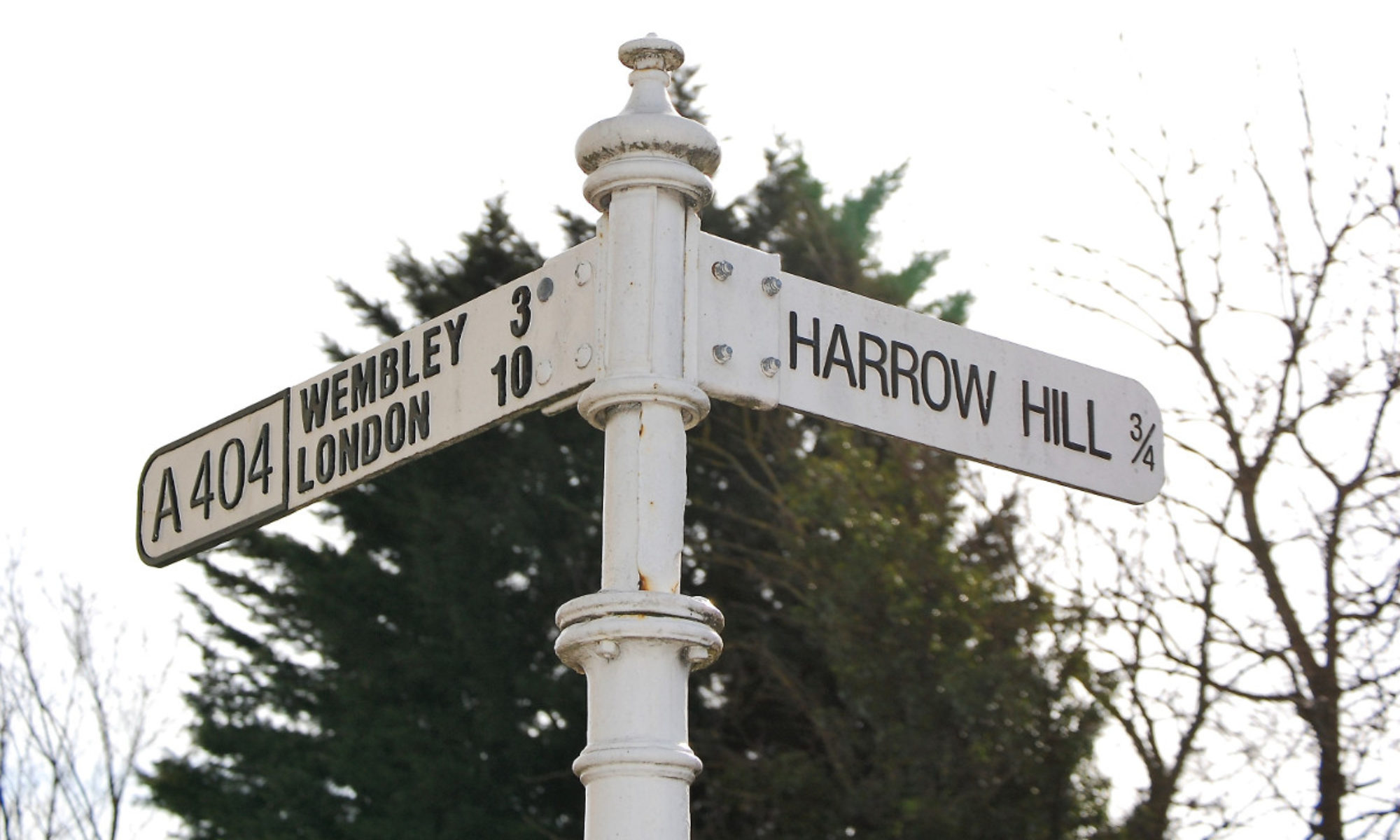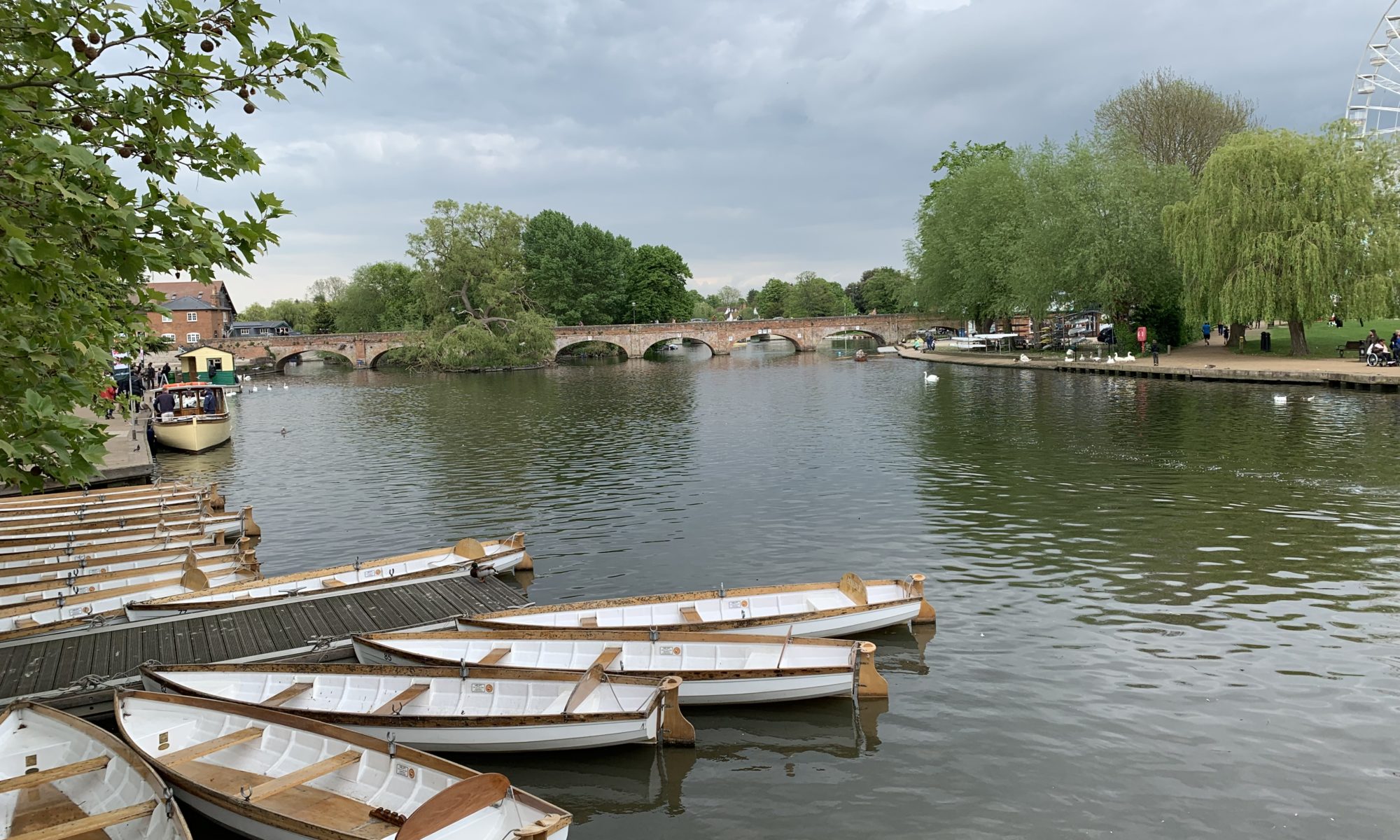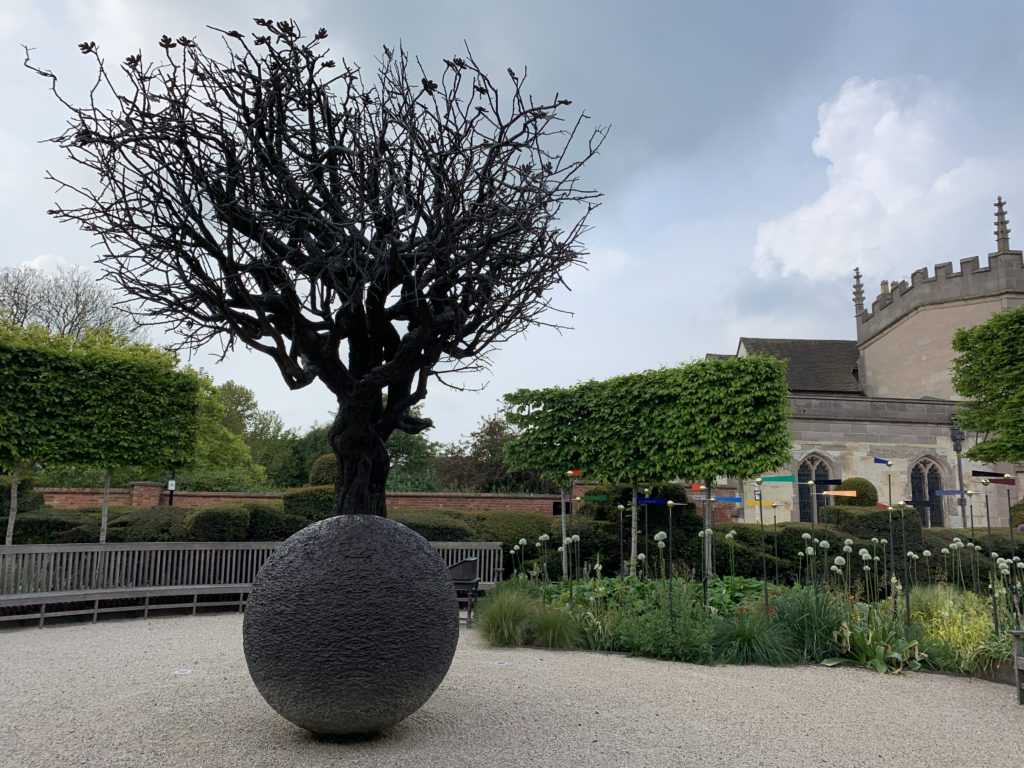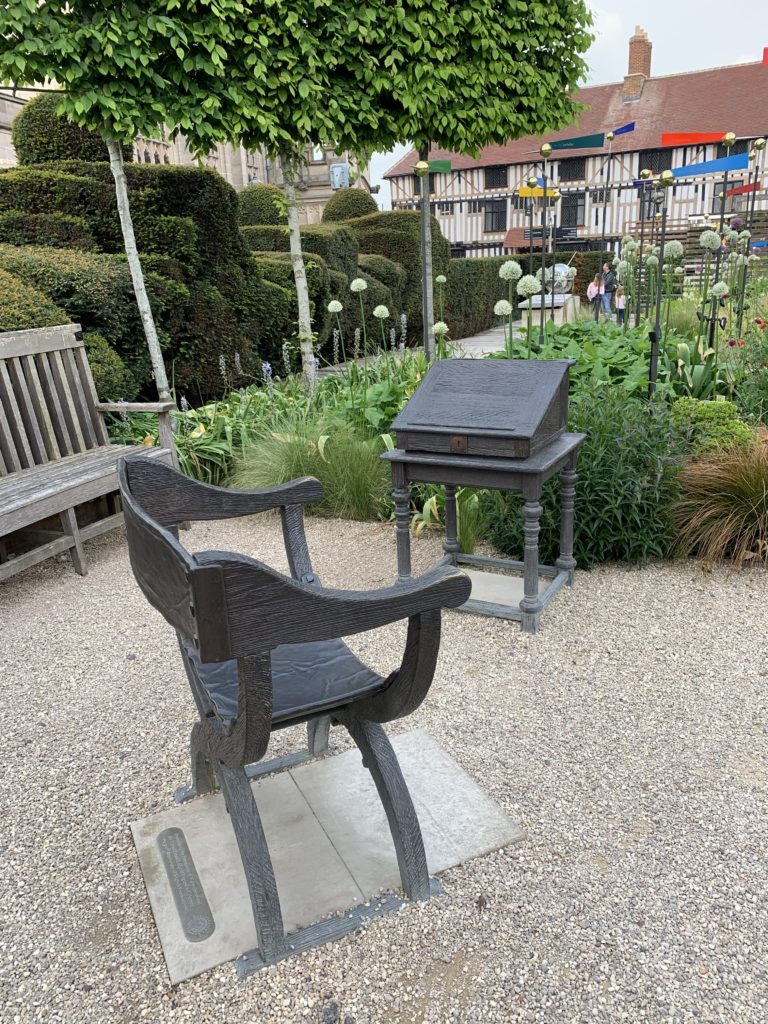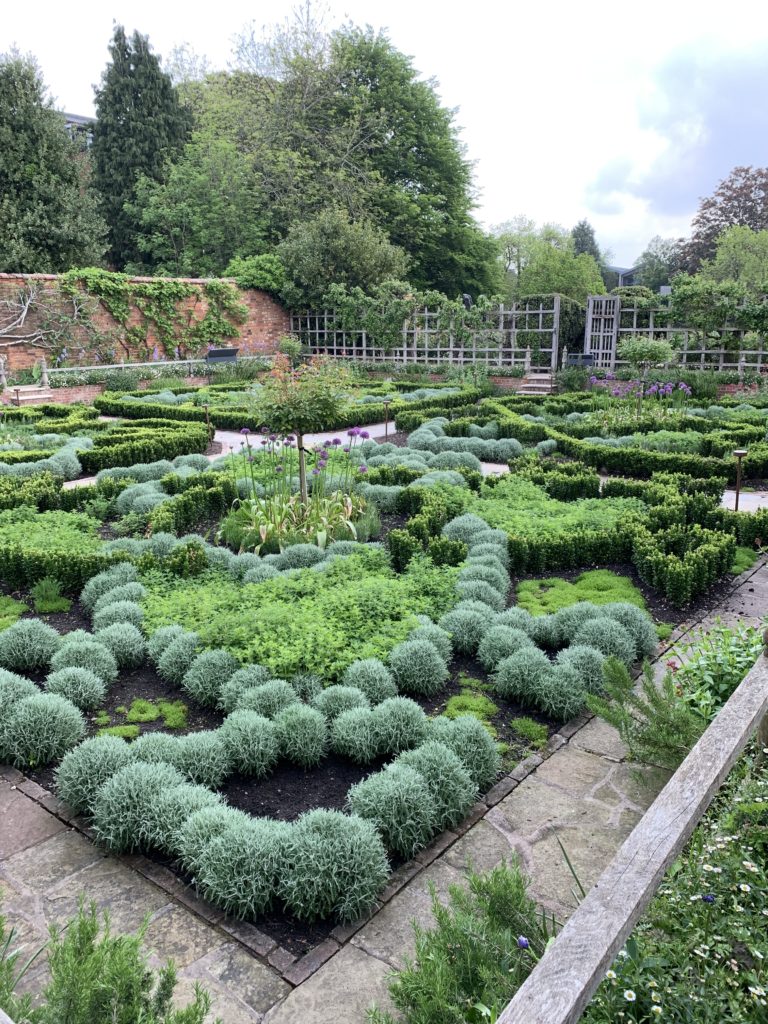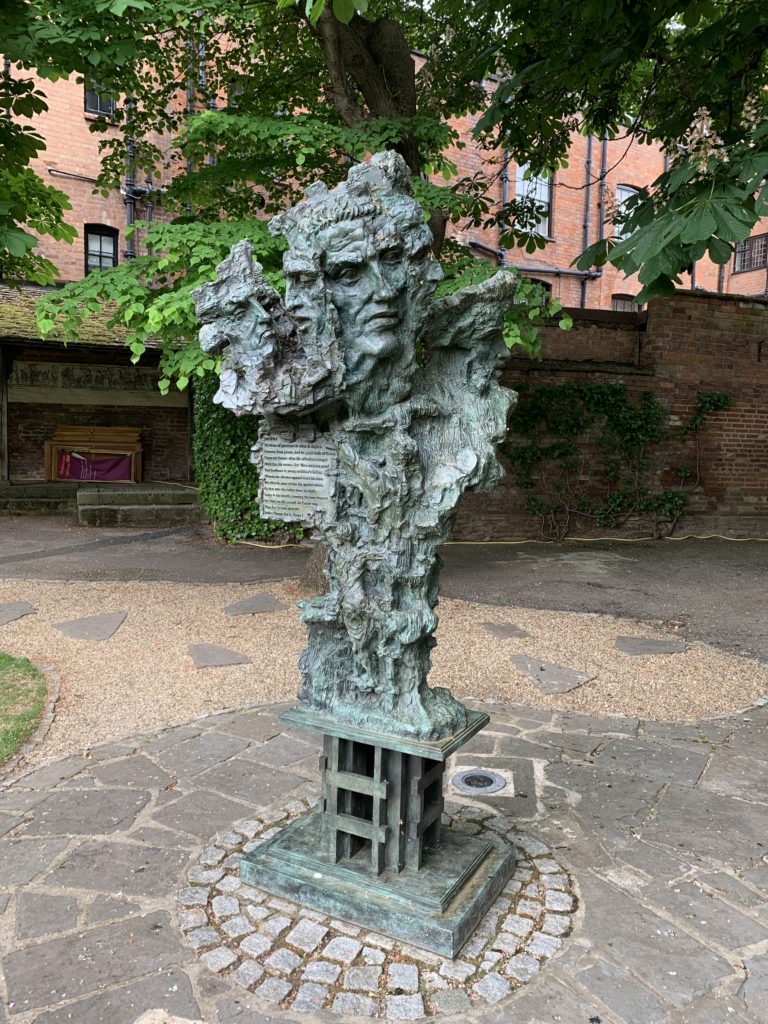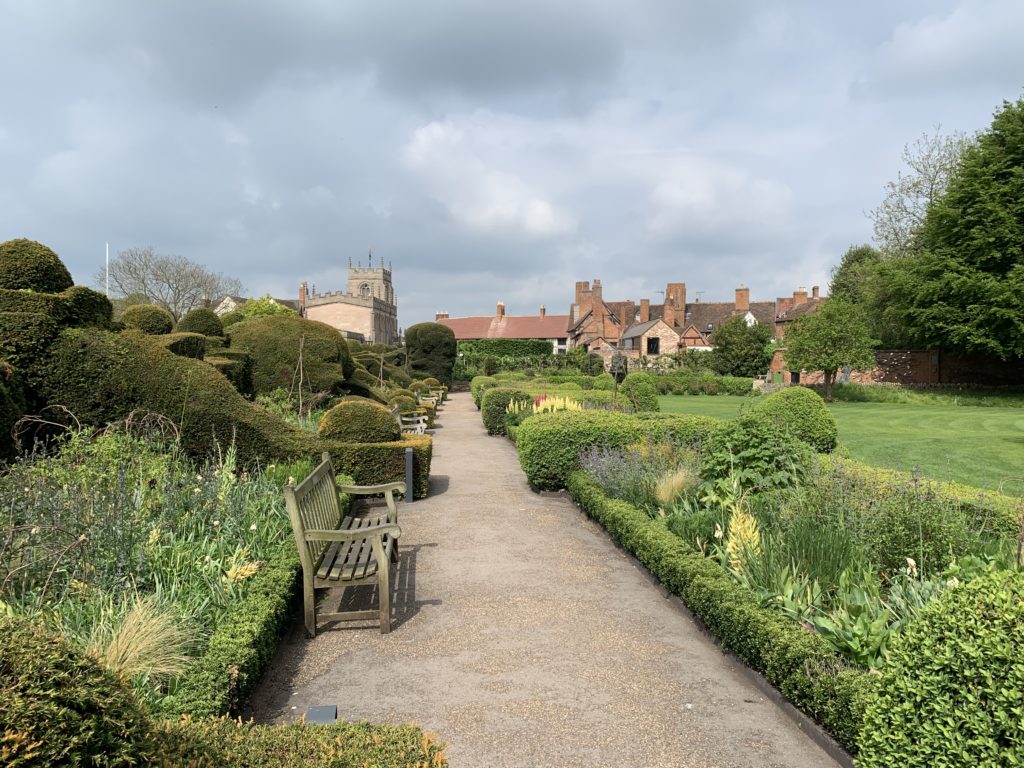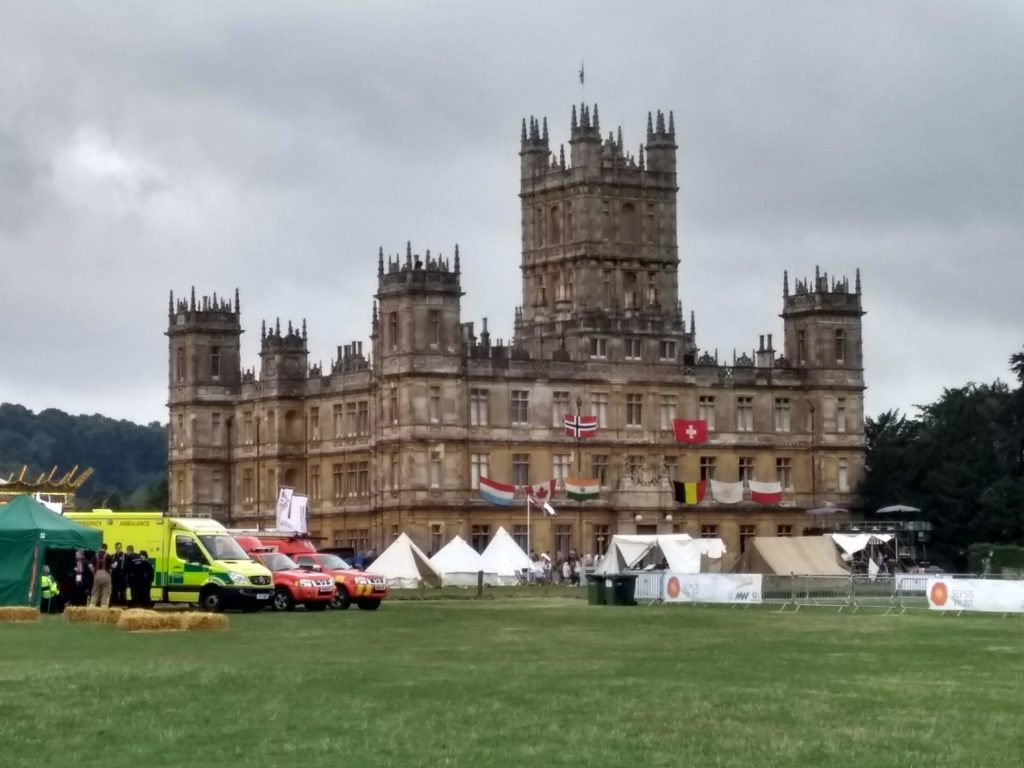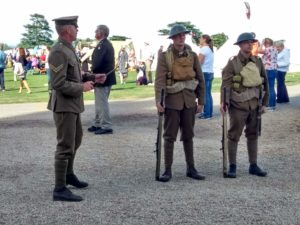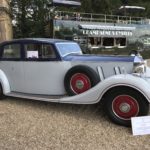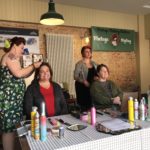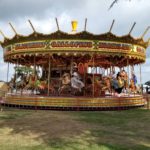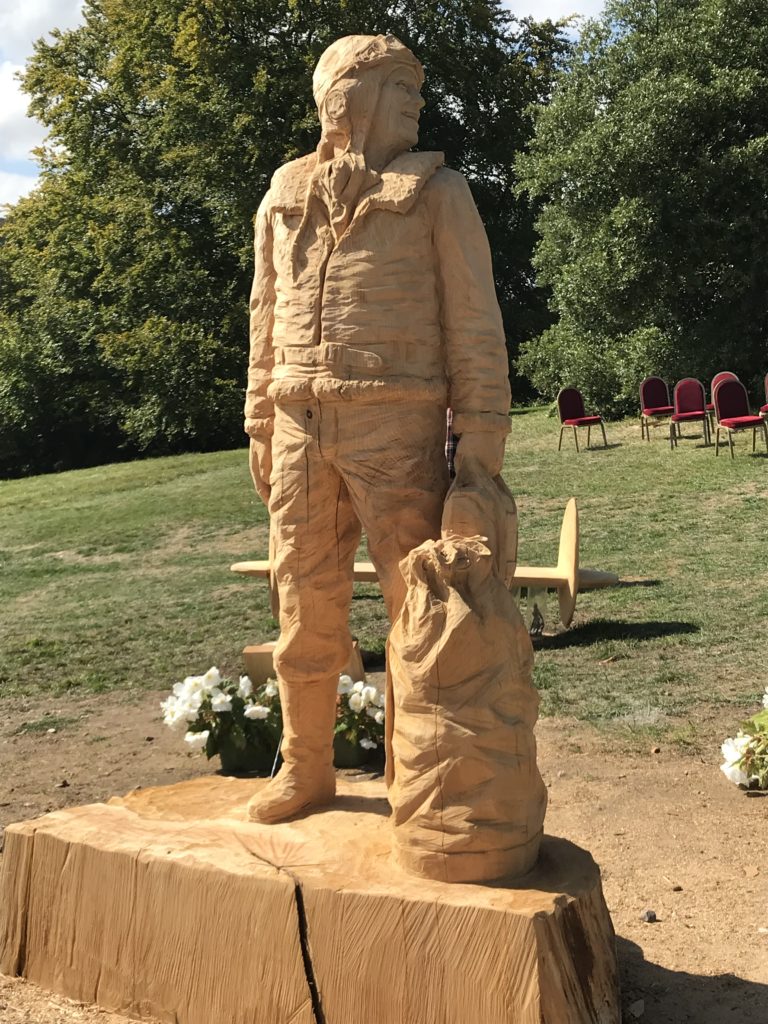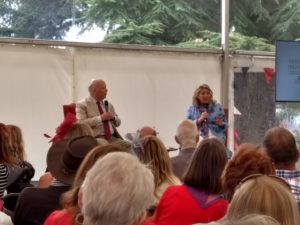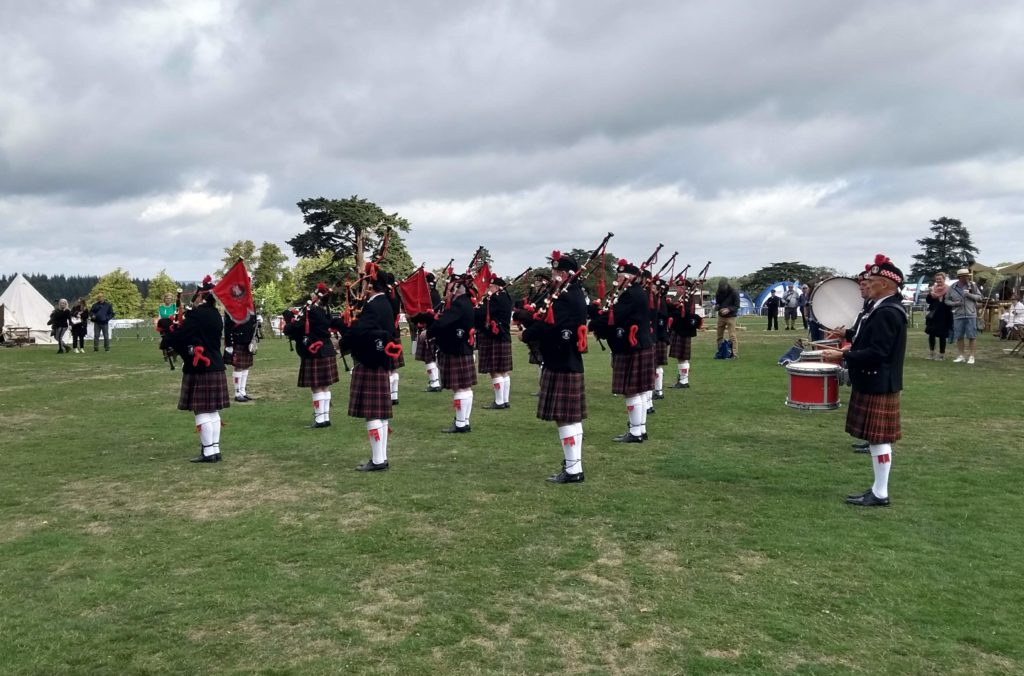Those wits, that think they have thee, do very oft prove fools. And I, that am sure I lack thee, may pass for a wise man. For what says Quinapalus? ‘Better a witty fool, than a foolish wit.’
Twelfth Night, Act 1, Scene 5
We could credit Shakespeare for bringing us together. We met online thanks in part to The Bard (and Kurt’s fondness for The Bard’s work). Kurt’s username was Better a Witty Fool. That and his exquisitely written profile are what first grabbed my attention.
Between that and being a pair of book and theater nerds, Shakespeare is part of our lives. Naturally, living in England required a pilgrimage to Stratford-upon-Avon. We did that in mid-May, hoping to avoid the summer crowds. Unsurprisingly, there were still crowds, but they didn’t spoil a glorious weekend in The Bard’s hometown.
Stratford-upon-Avon
Upon arriving in Stratford, our first challenge was parking the car (pro tip: don’t drive to Stratford unless you have pre-arranged parking). We had a hotel reservation at The Shakespeare, which we recommend but aren’t going to review here. Thankfully, they have a parking lot for guests; one that is not easy to find.
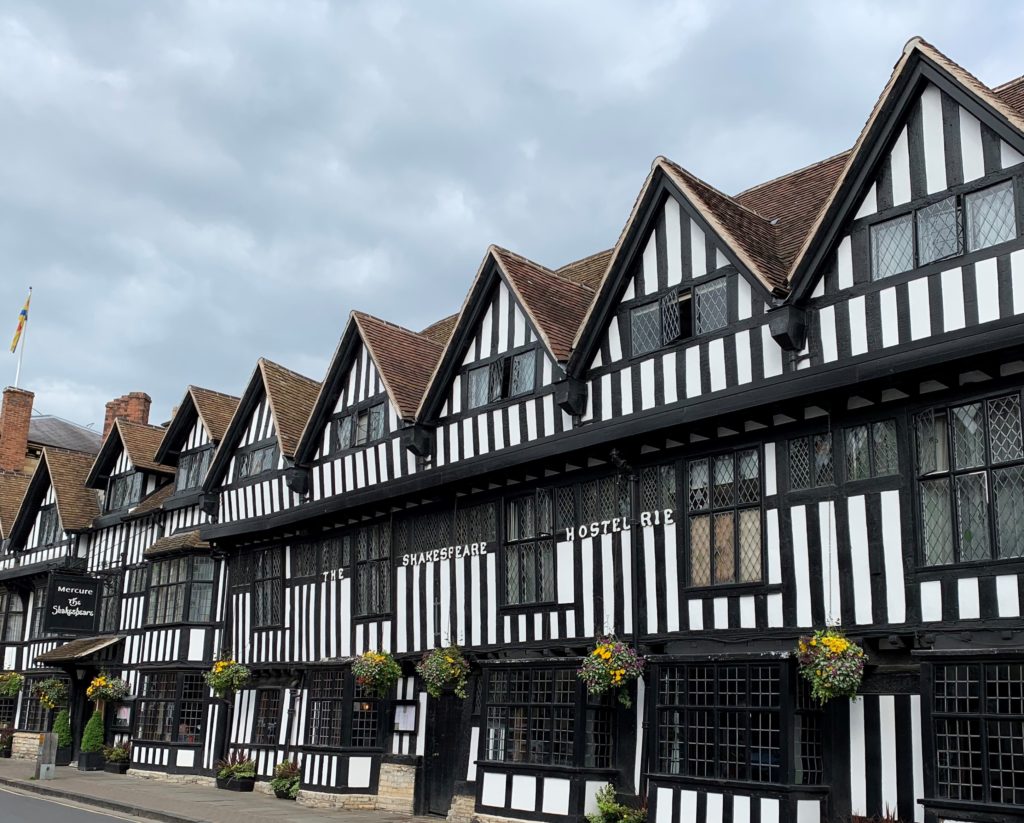
We drove around the hotel’s neighborhood, occasionally getting honked at as we looked for the parking lot entrance. I called the hotel’s front desk for directions. The woman who answered the phone told me the name of the street the entrance is on. She had a strong accent, so I asked her to repeat it. She did. I repeated back what I heard, “Ship Street,” and she corrected me by saying what sounded to me like what I had just said. That went on for a while until I just thanked her and hung up.
Eventually, Kurt dropped me off to go into the hotel and find the parking lot. I guided him to the entrance on Sheep Street by phone with only a few cross words between us and me almost getting hit by a car. So, all in all, that went well. Kurt crammed our mid-size SUV into the last somewhat-accessible, tiny parking space. Finally, our weekend could begin, and thankfully, that was the last of the cross words and frustration.
Royal Shakespeare Theatre
We were hungry, so the first order of business was a quick lunch. We had tickets for the matinee performance of The Taming of the Shrew. Unfortunately, the parking fiasco left us short on time, and the crowds meant every place had a line. Ultimately, we just had snacks and drinks at the theatre’s bar before the show.
While we were ordering, I spied an offer for a bottle of wine and cheese board for the interval (that’s English for intermission). We pre-ordered that and found a spot to enjoy our meager sustenance. Soon enough, we took our seats and the magic began.
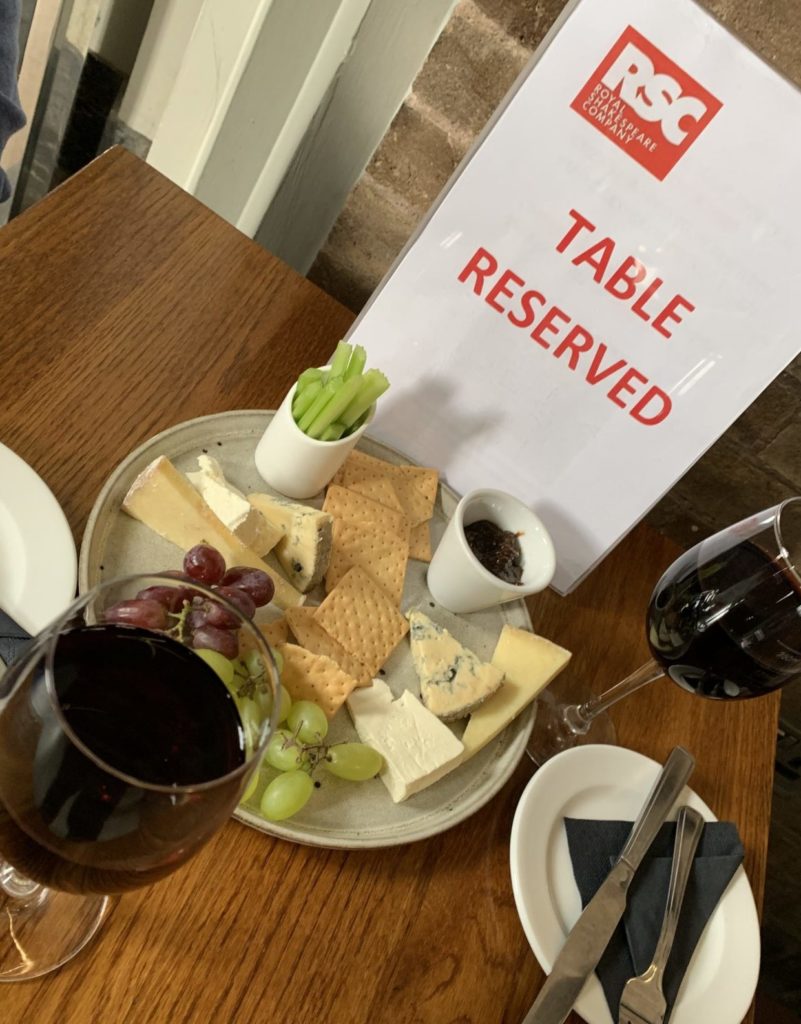
Shrew is one of Shakespeare’s more troublesome plays for modern audiences. We chose it because Kurt played Vincentio in InnerMission’s production a few years ago and because the Royal Shakespeare Company touted this performance as turning the play on its head. We’re not sure it succeeded in that lofty goal, but the staging and performances were magnificent. The show featured one of the most broadly inclusive casts either of us have seen on stage.
At the interval, we headed to the bar and found our wine and cheese board waiting for us at a reserved table. We felt a little posh as we enjoyed it and the interval passed far too quickly!
Shakespeare’s Final Resting Place
After the show, we walked along the river to Holy Trinity Church, where Shakespeare and most of his family are buried. He was also baptized there in 1564, and it is probably the church he attended growing up. The church is beautiful, and his grave is in the chancel. Because it receives so many visitors, the church charges a small fee for access.
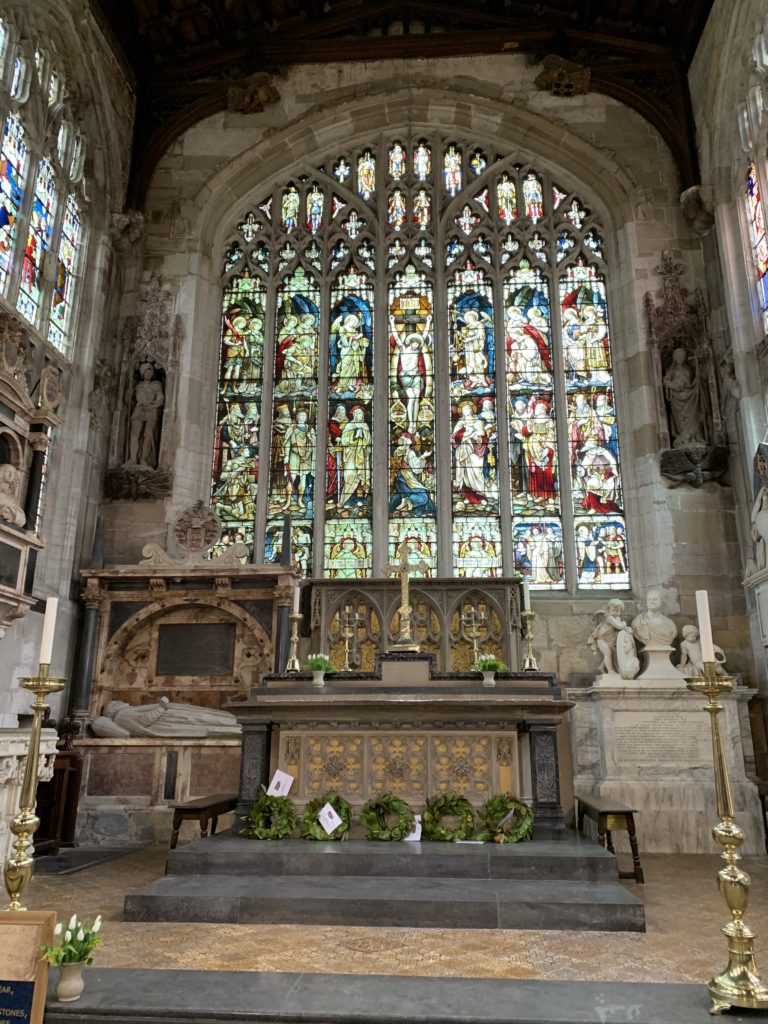
The Chancel 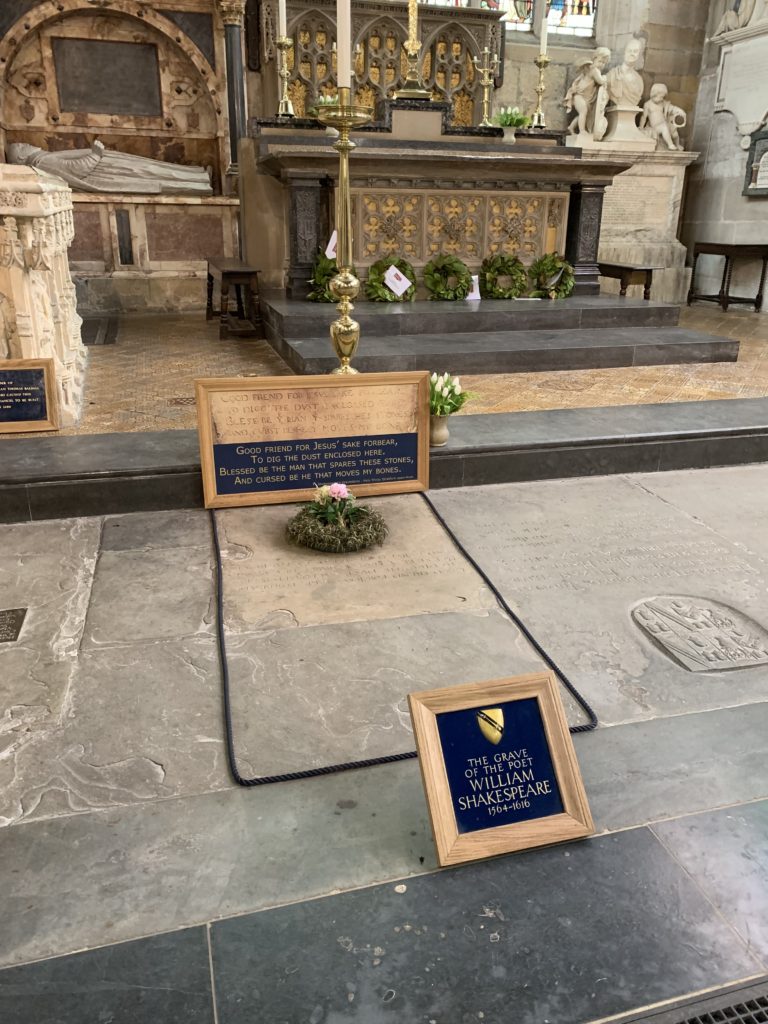
Shakespeare’s Grave 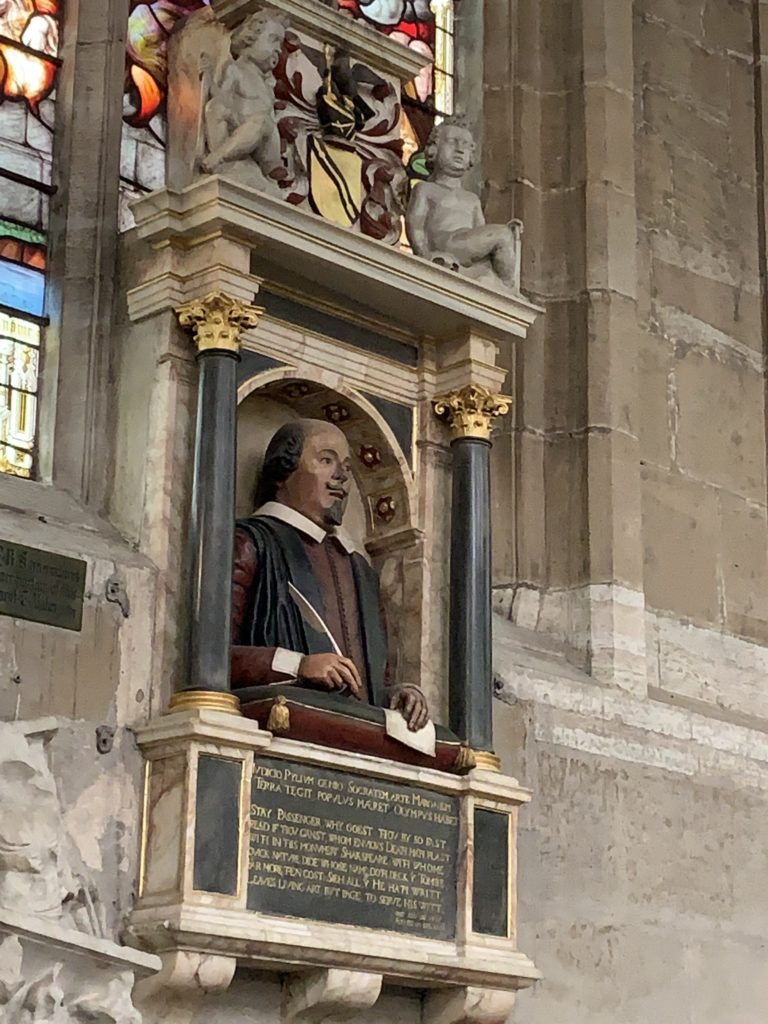
The Monument
There is a monument to Shakespeare on the wall above his grave that includes a bust of his likeness. It was erected a few years after his death and before his wife died, so it is believed to be a good representation of what he looked like.
From there we walked to nearby Hall’s Croft. This was the home of Shakespeare’s daughter Susanna and her physician husband. While it includes some information about Susanna’s life, it contains a great deal of information about and artifacts from medical practices in those days. Suffice it say, it renewed our appreciation for modern medicine!
We enjoyed the Tudor architecture surrounding us, knowing that we were walking the same (albeit now paved) streets that Shakespeare once walked.
Dinner and a Stroll
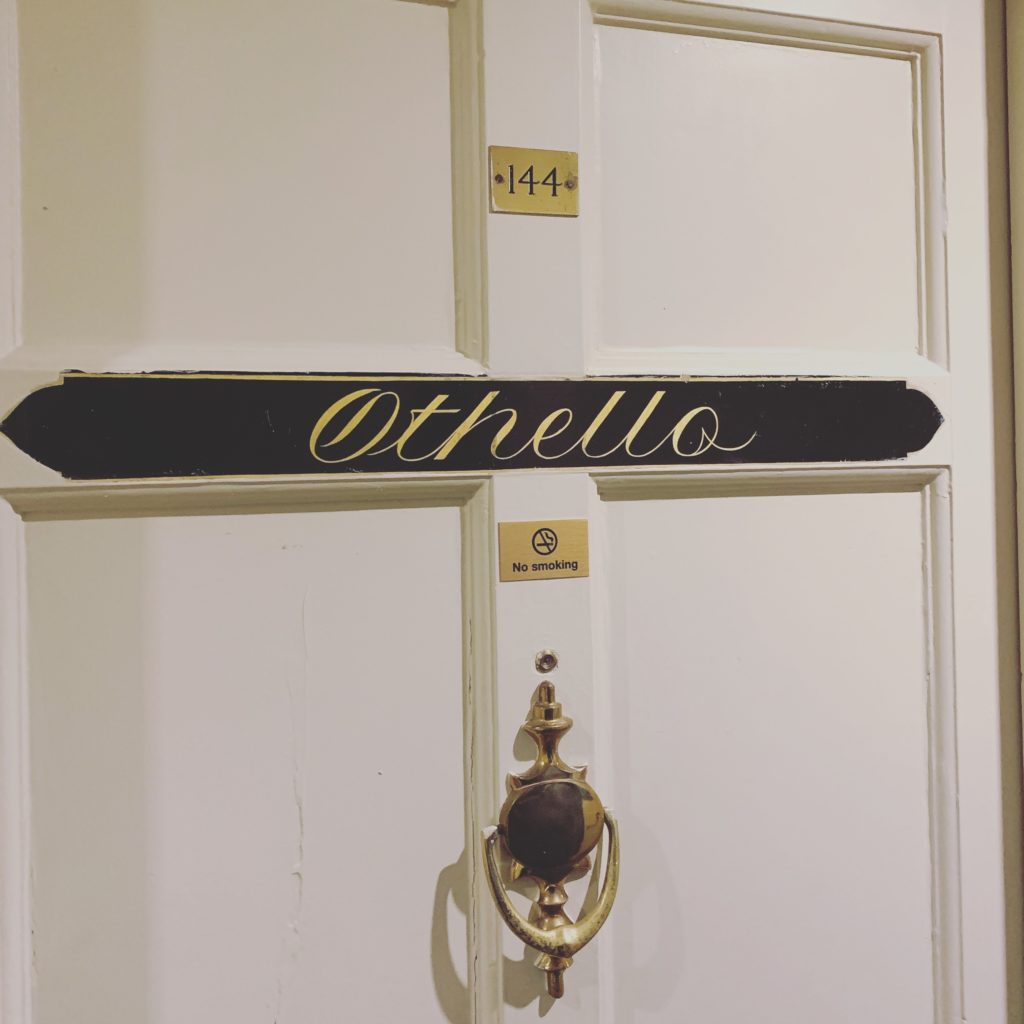
We returned to the hotel to complete check-in and get our room key. Each room in the hotel has a name from Shakespeare’s plays. We were in Othello. I gave Kurt a little side-eye and warned him to stay away from the pillows.
After freshening up, we headed out for dinner. We enjoyed a delicious and leisurely meal at nearby Wildwood.
After dinner, we took a stroll along the river. The area near the theater that had been overflowing with people when we went to the show was now almost empty. We watched a dinner cruise canal boat go through the lock and then crossed the river on the pedestrian bridge.
Walking along the path on the east bank of the River Avon, we enjoyed near solitude. It’s a peaceful walk with views of the theater and church on the opposite bank, canal boats, ducks, geese and swans. About two-thirds of a mile downriver there is another pedestrian bridge, which we used to cross back across the river. We watched a territorial swan harass two ducks with ducklings as we were crossing.
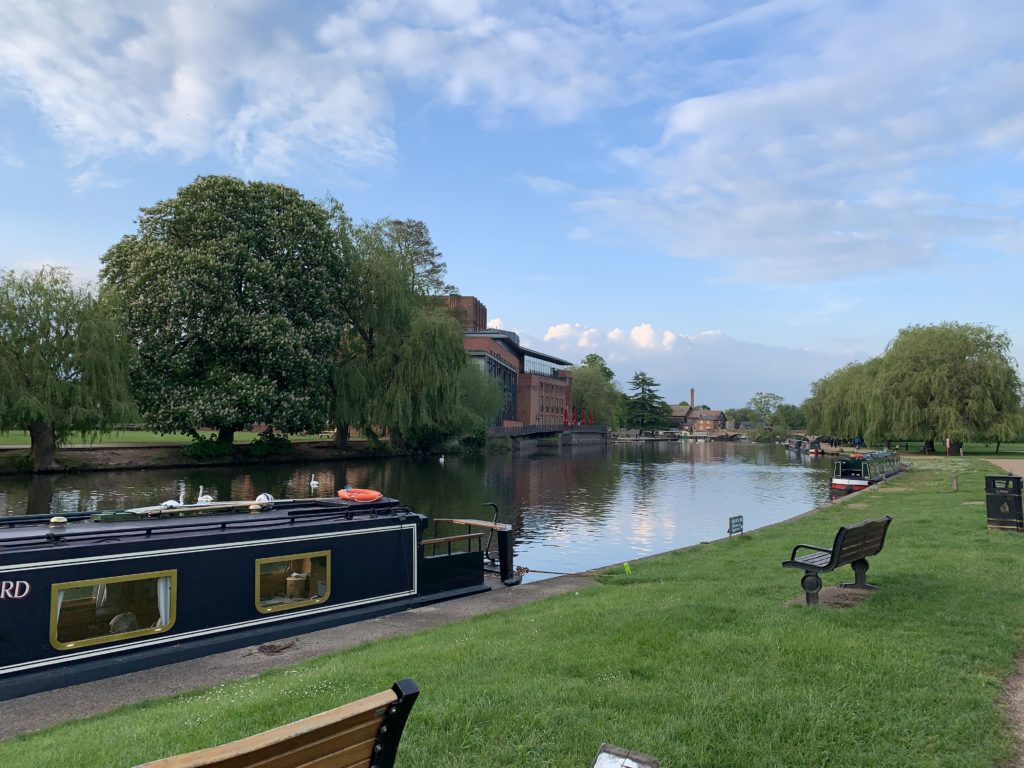
The Shakespeare Theatre 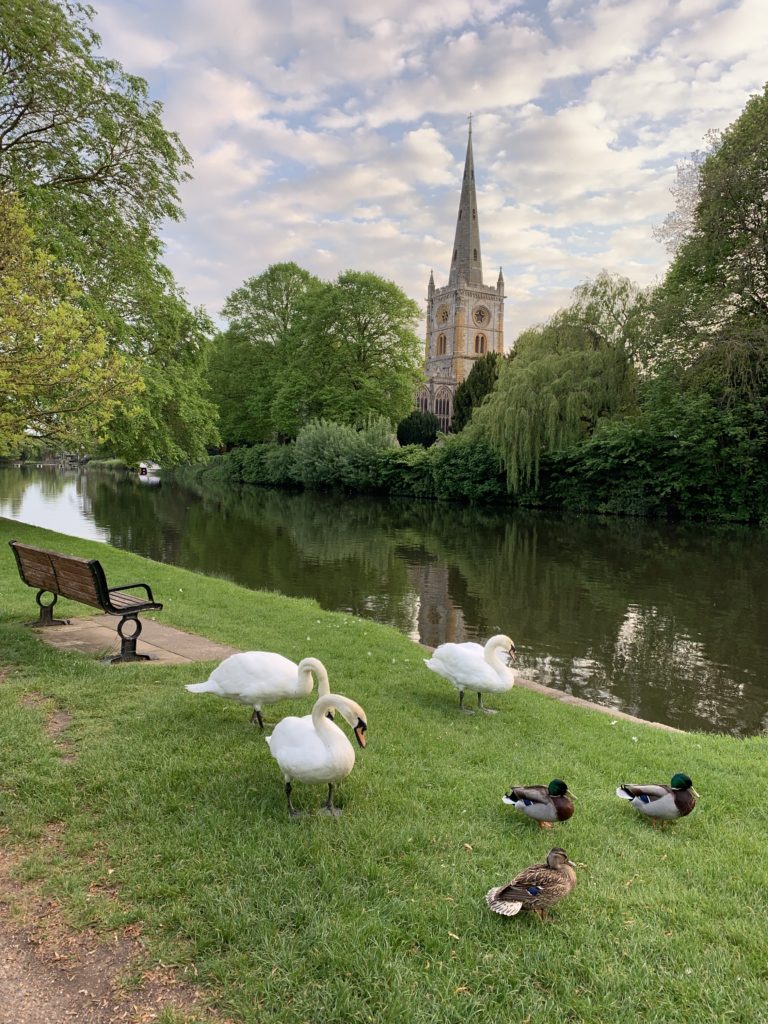
Holy Trinity Church and River Avon
The sun was starting to go down, so we walked back to our hotel. Once settled in our room we watched the Eurovision Song Contest finals. If you haven’t seen Eurovision, do yourself a favor and check it out. Graham Norton is the commentator for the finals, and it’s as hilariously brilliant as you could hope for. We especially loved Iceland’s entry.
Shakespeare’s Birthplace
Sunday morning, we were up early for breakfast before walking to Shakespeare’s Birthplace. The key to avoiding the crowds and getting good pictures is getting up early. The streets were nearly empty as we walked to Henley Street, and I was able to get a picture of the home where Shakespeare was born and raised with no one in it. We were among the first visitors and almost had the place to ourselves as we walked through.
There were two particularly special moments during our tour. The first was being in the room where he was born. Although none of the original furniture remains, it has been set up to resemble what was typical at the time. The second special moment was in the gardens when an actor offered to perform a soliloquy for us. We accepted her offer and were treated to a rather well-done rendition of “To be or not to be” made even more special by the enthusiasm of a non-native English speaker who clearly has a passion for Shakespeare.
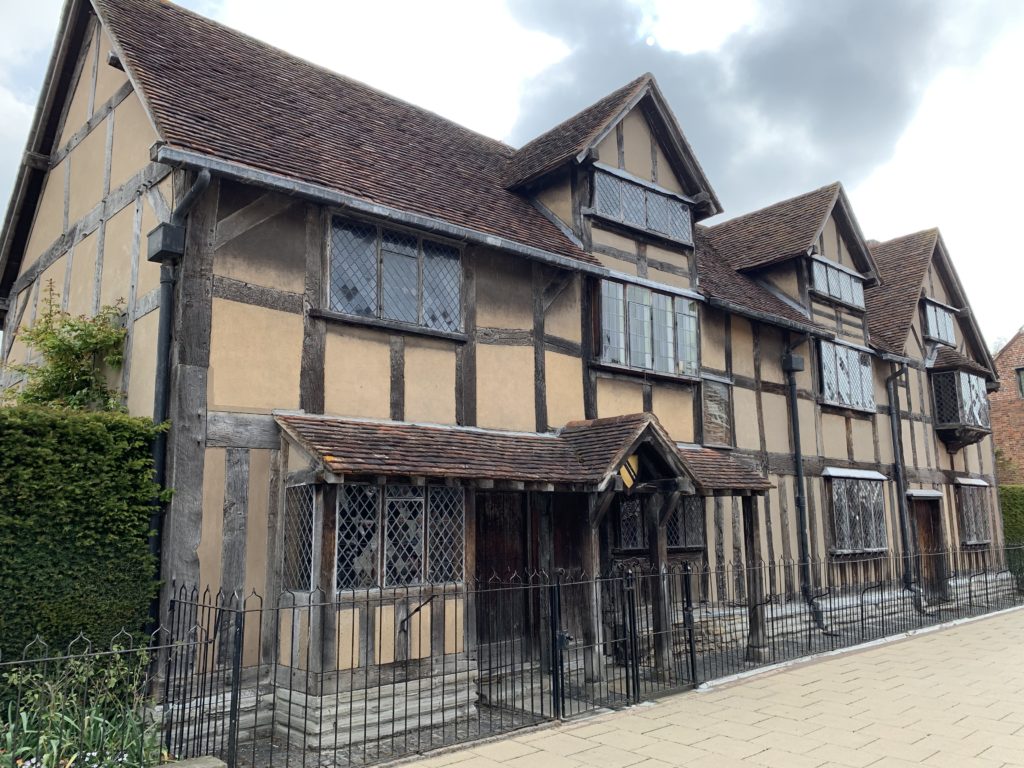
Shakespeare’s Birthplace 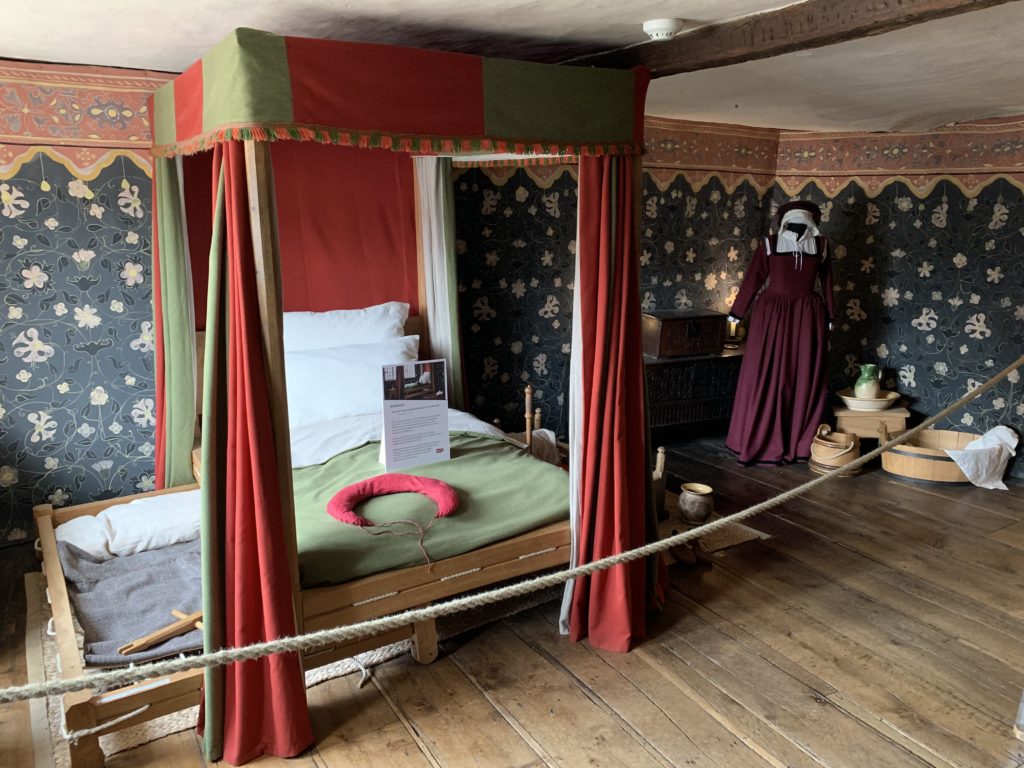
The Room Where It Happened
After a stop at the Hathaway Tea Rooms for a cuppa (cup of tea) and a scone, we visited Shakespeare’s New Place. This is where he lived after achieving success in London. The home itself is gone, but the grounds contain an exhibition and beautiful gardens dedicated to Shakespeare and his works.
Back to School
Our next stop was Shakespeare’s Schoolroom & Guildhall. Now, that was a unique experience and one that we recommend. Upon entering the schoolroom, the ‘schoolmaster’ greeted us and asked our names. We answered, but didn’t address him as ‘master,’ so he noted our names in his book for weekly punishment.
Recognizing that we were new and unfamiliar with the rules, he explained his expectations to us. At this point four more ‘new students’ entered the room and we watched as they experienced a similar greeting. Once we were all familiar with classroom expectations, the Latin lessons began. Teaching in Shakespeare’s day involved a lot of repetition. We now know how to conjugate ‘love’ in Latin.
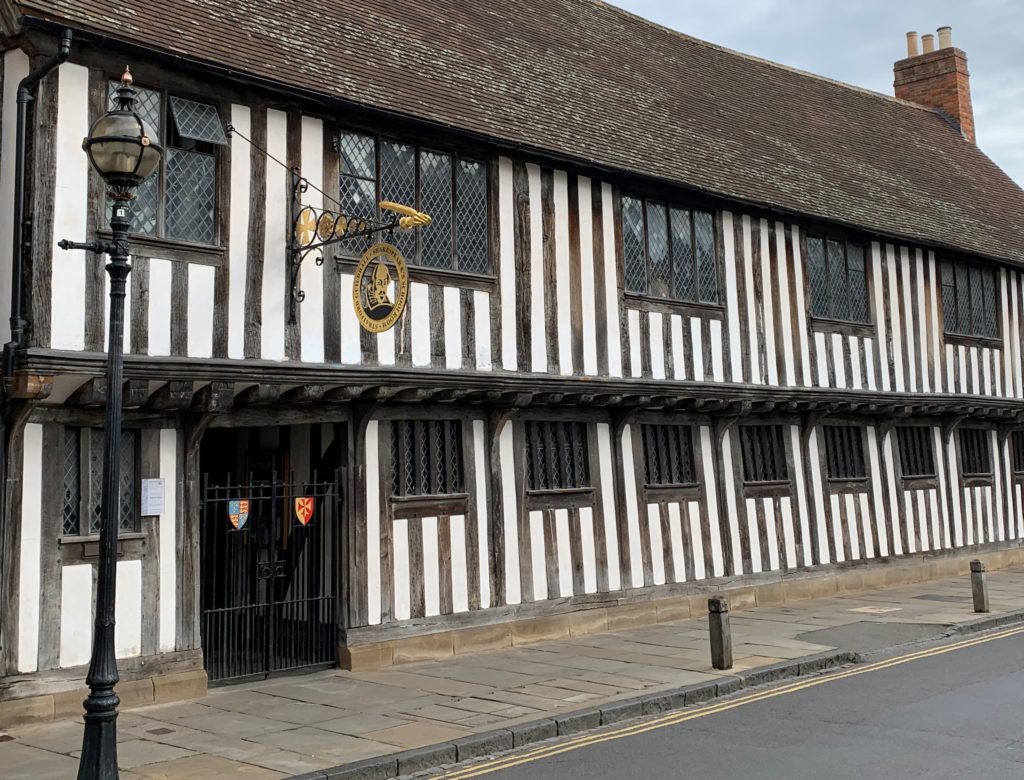
Shakespeare’s Schoolroom 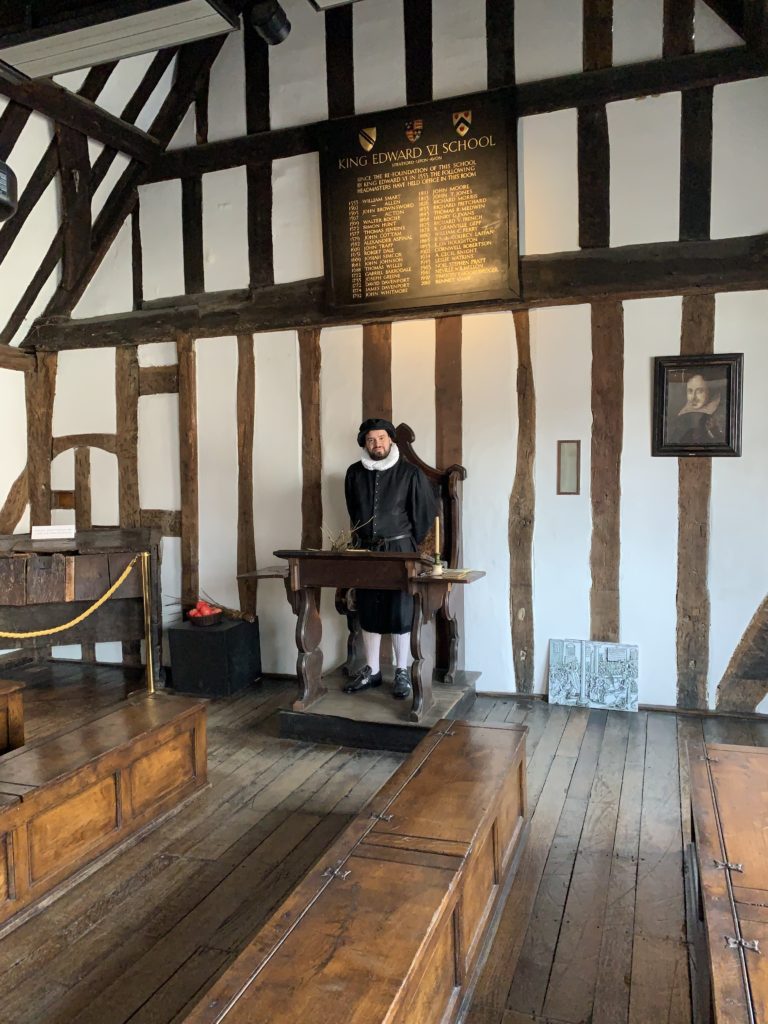
The Schoolmaster 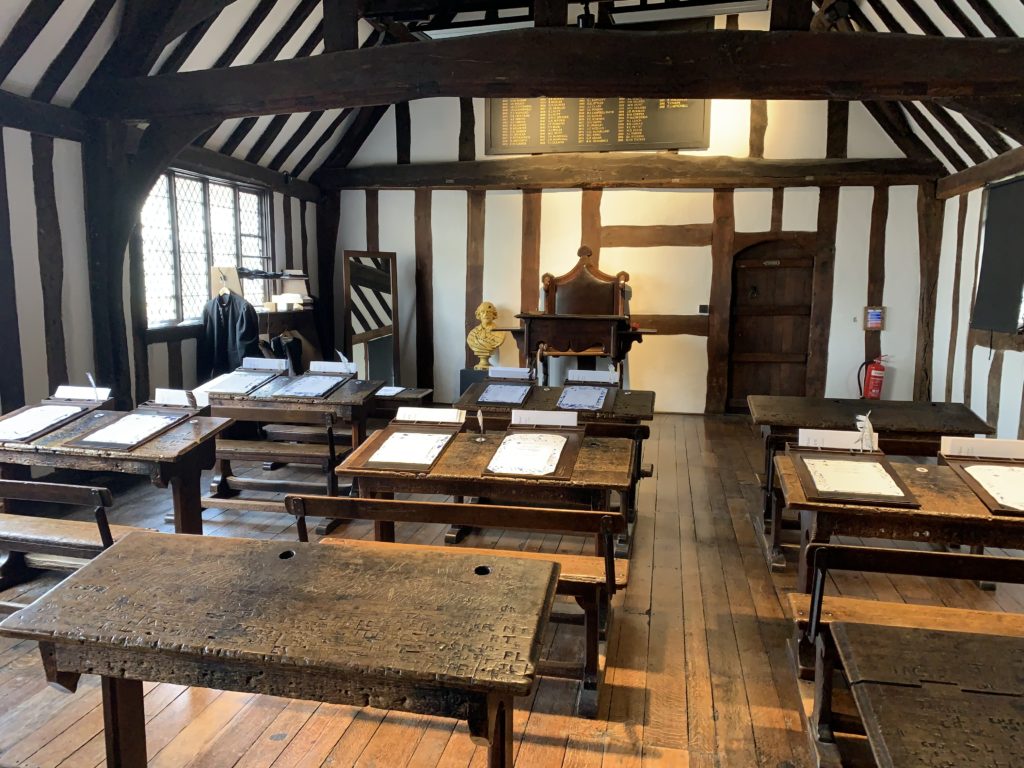
After being released from our lesson, we explored the rest of the school rooms and guildhall before returning to the hotel for checkout. We managed to extract the car from the tiny parking lot without incident and drove to Anne Hathaway’s cottage just outside town.
Anne Hathaway’s Cottage
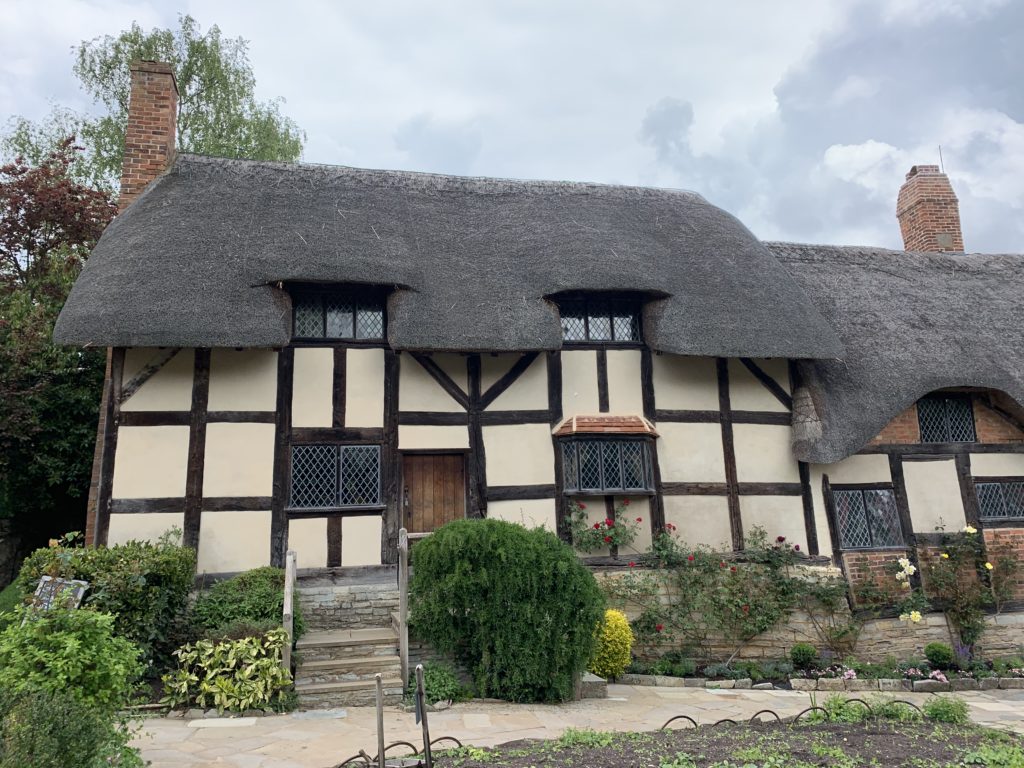
The last stop of our Stratford weekend, the cottage where Shakespeare’s wife was born and raised, was a relaxing finale. We learned that members of Anne’s family lived there until 1911. They were its caretakers for years after it was sold to the Shakespeare Birthplace Trust in 1892.
Some of the furniture in the cottage is from when Anne lived there, including a chair that Shakespeare reportedly sat in when visiting her before they married.
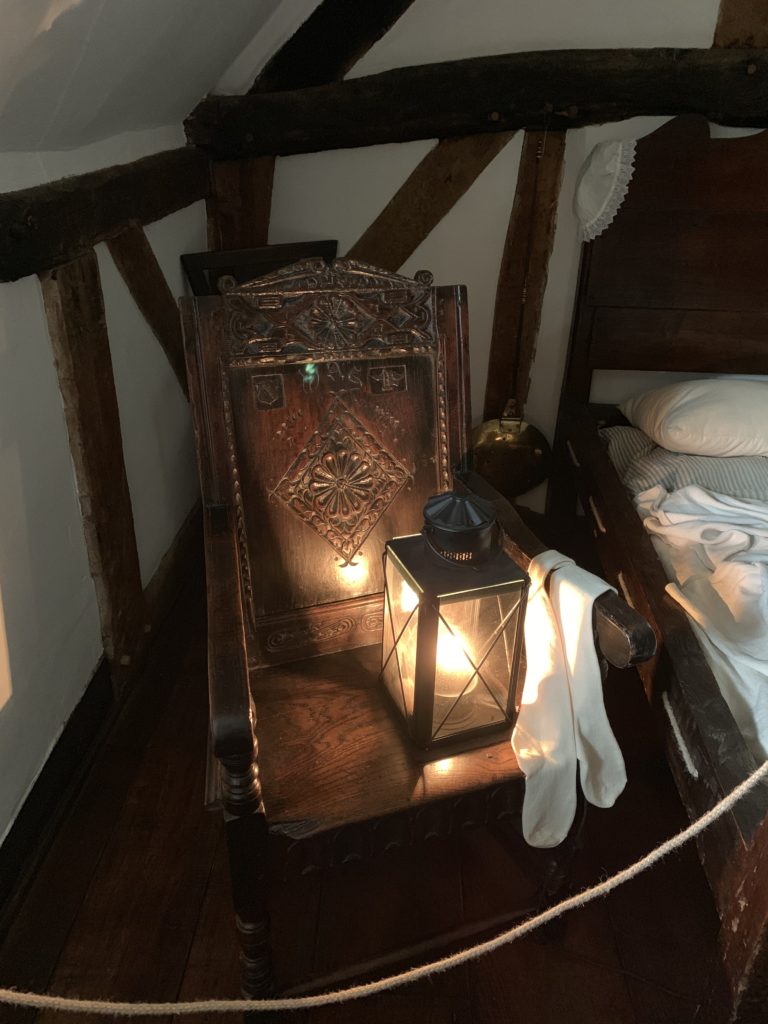
Did Shakespeare sit here? 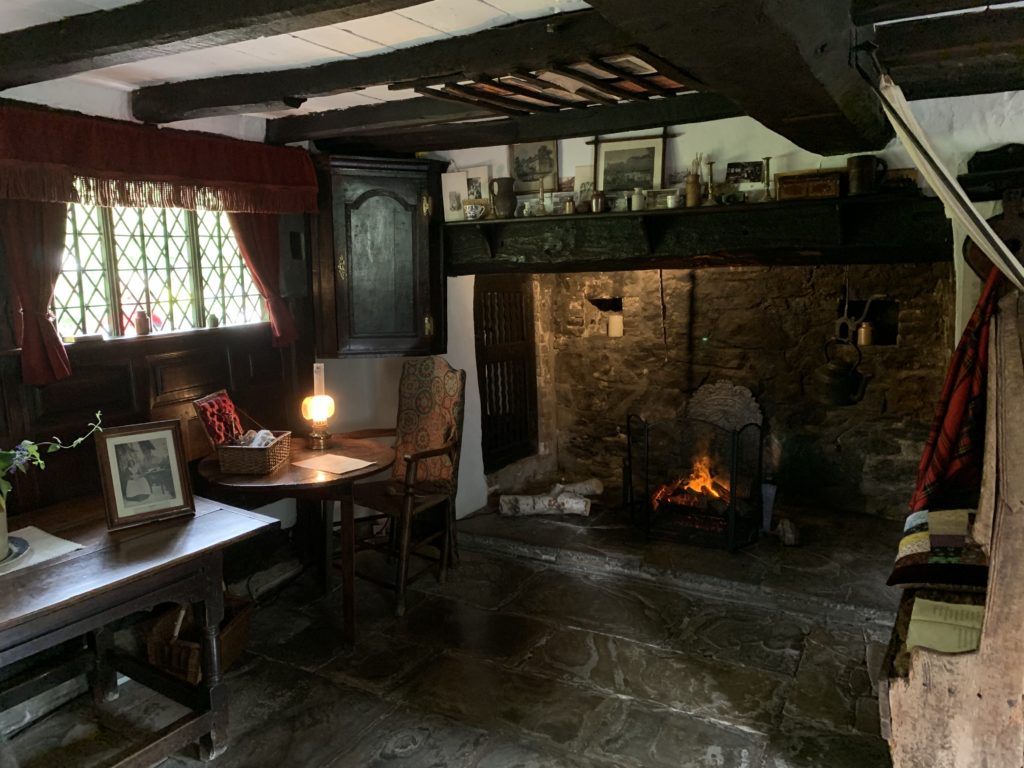
Kitchen of Anne Hathaway’s cottage
After touring the cottage, we ate lunch at the café across the street. Kurt drank cider made from apples grown in the cottage’s orchard, and we sat on the patio to eat. As we were finishing our lunch and enjoying the view of the cottage, it started to rain gently. That seemed a perfect way to end our Stratford weekend, and we walked back to the car arm in arm under one umbrella.
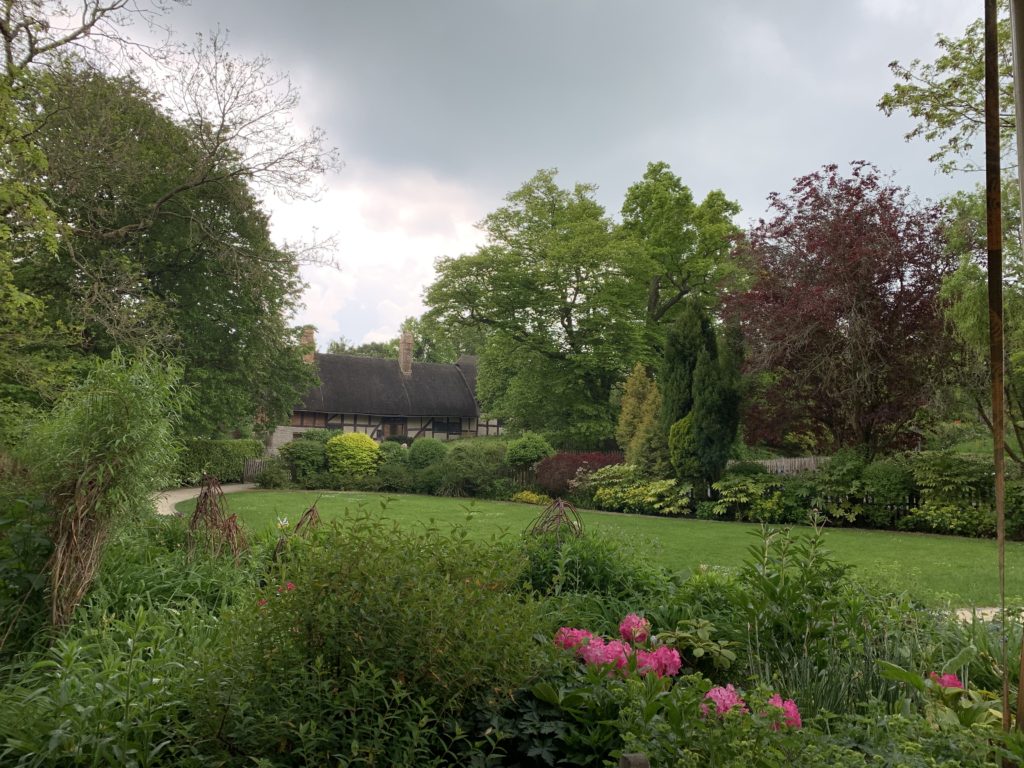
View of the cottage from our lunch table
